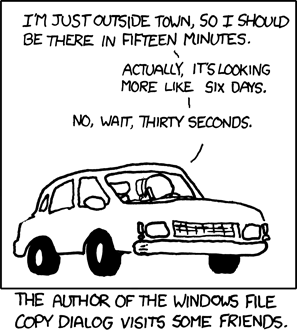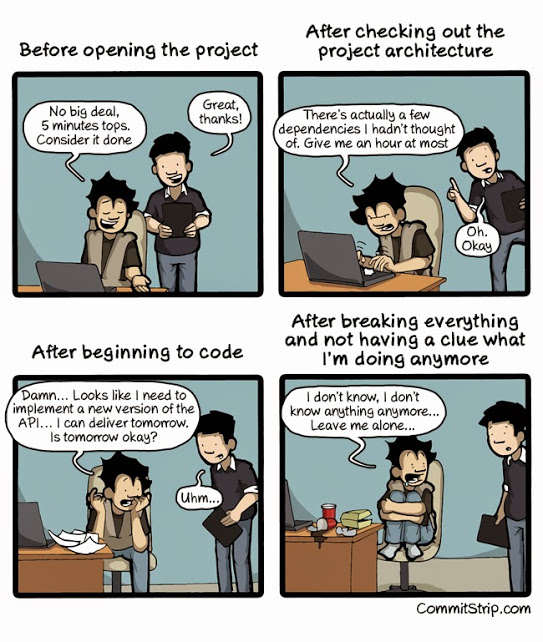Do you always feel behind in your work? Do you find yourself achieving less than you hoped fairly often? Do some projects last forever while other projects are done well and timely? Or, do you feel like the Windows progress bar?
Some people are awesome at time estimates while others are not. If you are anything like me (and I would believe many freelancers are but not including you, of course), then you have been or are really bad at estimating how much time a task or a project will take. Perhaps you estimate you’ll need about a half hour so you tell the client 1 hour to give yourself some space and time for "who knows what." When you dive into the work, you discover that it really takes you 3-4 hours to finish. Now multiply that (4x) out across an entire project (4 x 20hrs = 80hrs on the project...ouch!).

Or, maybe you allocate 30 minutes for a task, and you’re done in 5-10 minutes. While some may think this is great to do on purpose, eventually clients will feel like they are being exploited (or taken advantage of), and since we should strive to have integrity in our actions, even this approach is not valid. Padding our time estimates is not sustainable and most prefer not to work hourly, but understanding the amount of time it will take you is essential to improving your ability to quote projects at a flat fee and make that goal profit. How can we improve our time estimation?
This can be done with the 4 C's:
- Capture Your Estimations
- Clock your Actual Time Spent
- Calculate Your Fudge Ratio (or consider the Alternative)
- Change All Your Time Estimations
1. Capture Your Estimations
First, make a list of the tasks in your current or next project that you need to complete. This could be something like:
- Setup local environment.
- Create a local vagrant site
- Create a git repository
- Synchronize git repository
- Setup deployment
- Etc...
Once you have this list (and Trello makes a great place to create those lists). Next you want to write down the time estimates next to each task for how long you expect to complete each task.
2. Clock your Actual Time Spent
Next you will want to track your time. If you are not used to tracking your time, this will be a struggle. I use Freshbooks to track my time (and has an app that I use for the actual timing) and send invoices.

Some other timer alternatives include:
- Klock (Cross-Platform, Adobe AIR, Free Limited)
- Manic Time (Windows, Free)
- Slim Timer (Web-Based, Free)
- Rescue Time (Windows/Mac, Free)
- Project Hamster (Linux, Free)
Using your preferred time tracker, record your time for each of the tasks that you estimated. Now, we are ready to determine our Fudge Ratio.
3. Calculate Your Fudge Ratio
The Fudge Ration was first presented by Steve Pavlina. Essentially, the fudge ratio tells use the proportion of time under/over-estimated.
The Fudge Ratio is the ratio of estimated time against actual time to complete any task.
To determine your fudge ratio, you need to do the following:
- Total Estimated Time: Add up the total estimated time for all your tasks
- Total Actual Time: Add up the total tracked time for all your tasks
- Create your ratio: (Total Estimated Time)/(Total Actual Time)
For example, if you estimate that a certain list of tasks will take 12 hours to complete, but they really take 15 hours, then your fudge ratio is 15/12 = 1.25. This means it took you 25% longer than expected to complete the tasks.
To determine the best ratio, it is best to have a variety of tasks over a period of time. Depending on your business, this could be done well in a half a week or a couple of months. Personally, because of the nature of being a WordPress developer, I believe we should measure a week's worth of work, and personally I would like to see the ratio over the span of two or three projects. You could also do different fudge ratios on a per project basis. For example, you could have a fudge ratio for creating a theme, a fudge ratio for creating plugins, a fudge ratio for doing SEO/marketing work, and a fudge ratio for support requests.
Change All Your Time Estimations
Obviously, the first thing we do is that we use this ratio to "fix" our estimates to our clients. This means being patient and instead of blurting out that it will only take you an hour. It is thinking, "I believe this will take me an hour but my fudge ratio is 2.0, so I am going to say 2 hours," and then communicating that thought to the client. Besides using the ratio to help improve your time estimates, I have also tried (sometimes well, sometimes poorly) to apply some other principles. Namely:
- Pause. Everyone's project is urgent. But like entertainment parks and water parks, we all rush to get into line and wait. There is a careful balance between understanding the importance of urgency and allowing the client's schedule to dictate yours. Pausing and waiting allows you to think about the tasks/project at hand and for them to sink-in and your mind to mull over it to see if anything else "pops" into my mind (like those tasks that I forgot about).
- Collaborate. The WordPress community does a great job helping one another. Most of us are more than willing to listen to projects and ideas and approaches to the project as a sounding board without expecting that we will be asked or contracted to do work. So, with projects that have elements that you may be unsure about, run the project by someone else.
The second thing is to apply the ratio to other parts of your business. Steve Pavlina remarks that his fudge ratio was 1.5 and because of this, he only allots for "5 hours and 20 minutes worth of tasks" daily. This idea was revolutionary for me. I easily thought of the basic application of the ratio to my estimates and creating/managing expectations. However, I did not consider the extended and extra benefits of applying the ratio to my daily tasks list or daily goals. Doing this prevents guilty feelings, shame, need to work more, becoming a workaholic and even self-sabotage.
An Alternative: The "Scotty" Principle
If creating a Fudge Ratio seems like too much trouble, you can rely on the simpler "Scotty Principle". According to the Urban Dictionary, it is:
(n.) The defacto gold star standard for delivering products and/or services within a projected timeframe.
The premise is simple:
- Calculate average required time for completion of given task.
- Depending on importance of task, add 25-50% additional time to original estimate.
- Report and commit to inflated time estimate with superiors, clients, etc.
- Under optimal conditions the task is completed closer to the original time estimate vs. the inflated delivery time expected by those waiting.
In actuality, Scotty always multiplied his estimates by 4!